Geranium or pelargonium is a common home plant that feels great outdoors in the summer. In winter, the plant needs a dormant period, which the gardener must provide at home.
In open ground, the plant does not winter, pelargonium can tolerate only a small frost, significant cold is fatal for it. It’s quite difficult to keep geranium in the apartment in winter, due to the temperature difference after autumn, the plant is often sick and can lose the main green mass. It is possible to cope with the main problems in cultivation, if preparation for the winter in the apartment is provided, right.
Content
Plant description
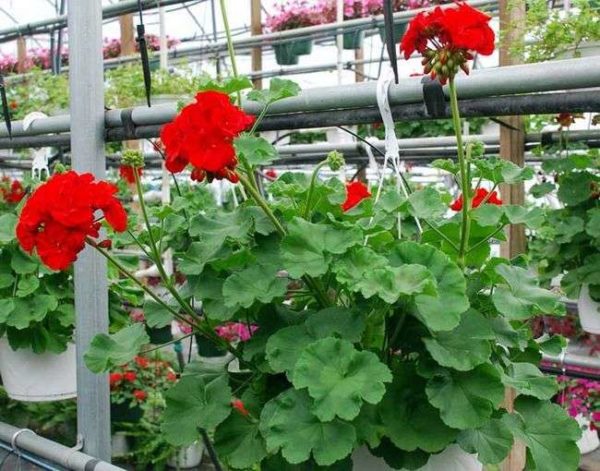 Geranium belongs to the genus Geraniev. Under natural conditions, the plant grows in South Africa. Now the genus has more than 250 species and annually new varieties developed by breeders are added to them. Their flowering differs in many respects from the usual “fist”, the bushes form themselves, do not stretch out due to lack of light, but also the usual geranium can be cut, ensuring the formation of a beautiful bush.
Geranium belongs to the genus Geraniev. Under natural conditions, the plant grows in South Africa. Now the genus has more than 250 species and annually new varieties developed by breeders are added to them. Their flowering differs in many respects from the usual “fist”, the bushes form themselves, do not stretch out due to lack of light, but also the usual geranium can be cut, ensuring the formation of a beautiful bush.
Plants of this genus can be divided into two groups:
- blooming - valued for lush flowering, which pleases the grower almost all year round;
- fragrant - this plant also blooms, but in comparison with previous species it is imperceptible, appreciated for the aroma emanating from the leaves, they can smell like lemon, mint, spruce and even Coca-Cola.
The root system of the plant is branched. Stem - erect or creeping in some species. The leaves look like a dissected lobe, covered with small hairs. Flowers are presented in the form of inflorescences - brushes, on it there can be more than 40 buds.
The plant blooms year-round while ensuring the temperature regime, daylight hours and regular application of mineral fertilizers in the soil. After the inflorescence ripens, a box-shaped fruit is formed, which contains small seeds.
Periods of growth and rest
The plant has a short rest period and enters the sleep phase in December. A new vegetative cycle begins in late February - early March. For the plant dormancy period, growth retardation and lack of flowering are characteristic. Providing a sufficient length of daylight hours, the plant can gain color, but it is recommended that the buds be removed because the geranium should rest. The lack of rest will not affect the summer flowering in the best way - the caps will be less magnificent. The growth period begins in March and lasts until the end of September. At this time, the plant needs to be fed with fertilizer with a moderate content of nitrogen and phosphates.
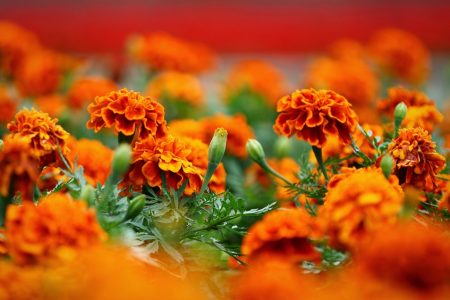 You may be interested in:
You may be interested in:To form a beautiful crown and maximum splendor, it is recommended to pinch the flower during the growth period. It is better to do this after flowering, then after pruning, the flower will again please the owner with dense greenery and massive flowering.Zonal pelargonium is recommended simply to pinch, for better branching. The ivy or ampelous geraniums need to be cut on each branch, after the formation of the seventh leaf.
Care for geraniums at home
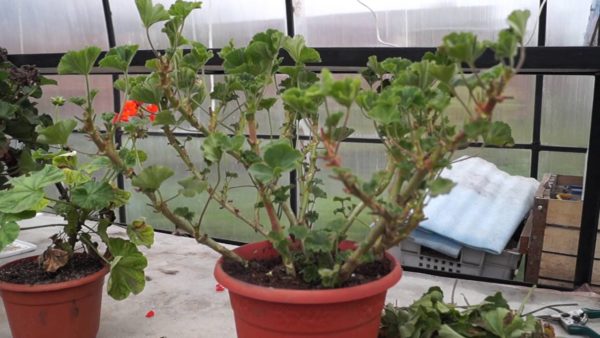 Geranium is a photophilous plant that feels great on the eastern or southern windowsill. Its leaves are tender, therefore from the hot, midday sun it is necessary to ensure shading, otherwise the foliage will begin to turn yellow and crumble.
Geranium is a photophilous plant that feels great on the eastern or southern windowsill. Its leaves are tender, therefore from the hot, midday sun it is necessary to ensure shading, otherwise the foliage will begin to turn yellow and crumble.
If the bush is formed incorrectly, it can be corrected by prolonging daylight hours. The result will be noticeable in the first month, the shoots will become smoother and thicker. If the geranium is standing in the room in winter, it needs to be kept cool - the optimum room temperature is 12-16 degrees. The plant responds well to fresh air, because the room needs to be ventilated, heating radiators dry the air, therefore it is better to purchase a humidifier.
Temperature and lighting in summer and winter
Plants need a break from summer flowering in order to re-decorate the front garden with bright hats next year. The optimal temperature in the summer when kept indoors is 22-26 degrees, for the winter it is recommended to lower it to 12-18. A pot of geraniums needs to be protected from drafts at any time of the year, because the plant has a fragile root system.
Kalachik is demanding on the length of daylight and lighting. Without a sunny color, the plant stretches and loses its decorative qualities, the stem partially discards the leaves and exposes itself. In summer, geraniums can be kept in the garden by putting a flowerpot on the street or even planting a plant from a pot in open ground. You need to place it on a partially shaded area. The flower needs the soft rays of the morning sun, and the midday heat can destroy it.
How often to water in the apartment
It is impossible to say that pelargonium is a hygrophilous plant, it does not tolerate the bay, because excessive soil moisture is destructive for it. It is necessary to water it at home after partial drying of the earthen coma, the plant tolerates temporary drought better than the bay. In winter, the plant is watered once every 10-14 days, and in the summer - every 2-5 days.
The choice of substrate and top dressing: how to fertilize
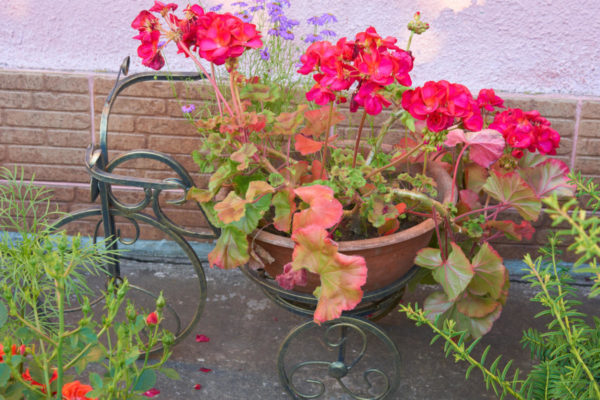 When keeping a plant, you need to remember what it needs proper care at home and annual transplant, implying a complete replacement of an earthen coma. You can plant the plant in any nutrient mixture with the addition of perlite and vermiculite. At the bottom of the pot you need to lay a sufficient layer of drainage. The plant loves spacious flowerpots and quickly grows in them, but for rapid flowering, the size of the pot must correspond to the root system. Planting in a large flowerpot will lead to the fact that the plant will increase the underground, root mass, forgetting about flowering.
When keeping a plant, you need to remember what it needs proper care at home and annual transplant, implying a complete replacement of an earthen coma. You can plant the plant in any nutrient mixture with the addition of perlite and vermiculite. At the bottom of the pot you need to lay a sufficient layer of drainage. The plant loves spacious flowerpots and quickly grows in them, but for rapid flowering, the size of the pot must correspond to the root system. Planting in a large flowerpot will lead to the fact that the plant will increase the underground, root mass, forgetting about flowering.
It grows rapidly if fertilizer is regularly applied to the soil from the beginning of March to the end of September. For lush flowering, compositions with a high potassium content are used, which should be used 2 times a month in the volumes regulated by the instructions. If the fertilizer is classified as complex, you need to pay attention to the nitrogen content in it, because high doses of the component will lead to a rapid increase in green mass and the rejection of flowering.
Pruning
Pruning is one of the difficult stages in caring for any plant, but gardeners who want to get a neat geranium bush and enjoy its flowering can not do without such manipulation.
The growth rate depends on the variety and pruning quality. As they develop, the stems are always stretched and exposed. In this case, the top of the stem is cut off and re-rooted, and the remaining bare stem with the root can be tried to resuscitate.The pot needs to be provided with complete care and good lighting, then young rudiments of future branches will appear on the bare hemp.
To exclude the formation of a bare stem, pruning is recommended to be done every year after the completion of the vegetative cycle. Cut the plant as much as possible to awaken sleeping buds. Since geranium does not stop growing completely, it becomes necessary to re-form after an increase in daylight in March.
Preparing for wintering: winter storage
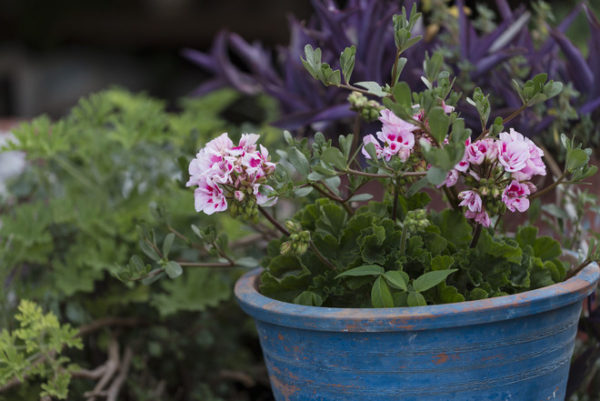 In autumn, the plant is cut as much as possible, leaving no more than 7 leaves on the stem. Be sure to remove the stepsons growing from the lateral sinuses, because they will suck out all the nutrients necessary for a successful wintering from the mother plant. To get abundant flowering, wintering of pelargonium should be cool, you can save plants on the windowsill or in the basement.
In autumn, the plant is cut as much as possible, leaving no more than 7 leaves on the stem. Be sure to remove the stepsons growing from the lateral sinuses, because they will suck out all the nutrients necessary for a successful wintering from the mother plant. To get abundant flowering, wintering of pelargonium should be cool, you can save plants on the windowsill or in the basement.
The process of preparing for wintering includes reducing watering, eliminating fertilizing with various fertilizers, pruning with the obligatory removal of peduncles.
When stored in the basement, you need to take into account that each plant is cut and removed from the soil, placed in a sealed container that will have to be ventilated at least 1 time 2 weeks. The basement for storage should be dry, the temperature in it should not fall below 10 degrees - otherwise the plant will die.
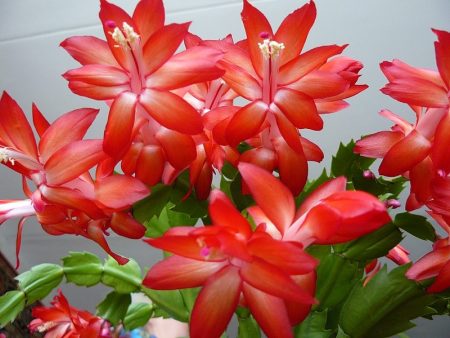 You may be interested in:
You may be interested in:Pelargonium wintering places
Suitable conditions for wintering are:
- a glazed balcony or loggia, provided that the temperature does not fall below 8-10 degrees;
- windowsill at a room temperature of not more than 17 degrees;
- cellar or basement - plants in flowerpots are placed in the most illuminated place, if it is impossible to provide natural lighting, the method is not used;
- refrigerator - without soil and roots, leave only the ground part in the form of a stem, you need to regularly check the condition of the plant.
For adult plants to successfully winter, they must retire healthy. At the end of August, plants planted in open ground should be inspected for pests.
Reproduction and transplantation
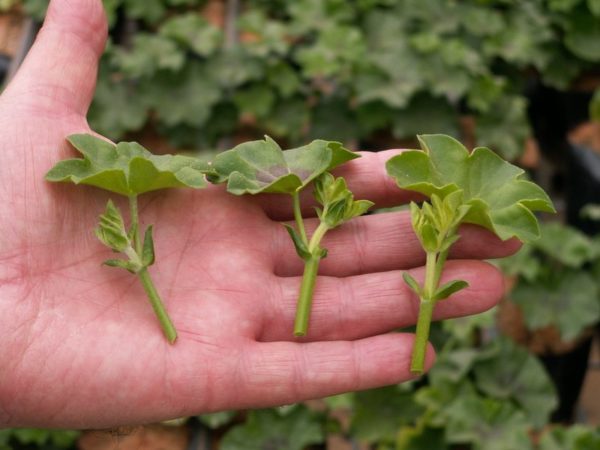 For propagation of the fist, 2 methods are used: cuttings and sowing of seeds. The first method has one drawback - it is important to choose the right seed. Affected by pests or diseases cuttings will not be able to take root. With the seed method, the difficulty lies in caring for the planting. It is important not to overfill the young plants and to air the organized greenhouse in a timely manner.
For propagation of the fist, 2 methods are used: cuttings and sowing of seeds. The first method has one drawback - it is important to choose the right seed. Affected by pests or diseases cuttings will not be able to take root. With the seed method, the difficulty lies in caring for the planting. It is important not to overfill the young plants and to air the organized greenhouse in a timely manner.
Seeds: how to care
Kalachik breeds well with seeds, they can be collected independently from a flowering bush or purchased in a store. Store seeds need to be checked for expiration date, if they are collected recently - germination will be high.
Seeds are planted in a loose, slightly moistened and previously disinfected with a solution of potassium permanganate solution, close up to a depth of 2 cm. The pot with fresh seeds is covered with glass or plastic wrap and kept at a temperature of 18-22 degrees. Glass is removed after germination. Pinch the sprout after the formation of 5 leaves. Spray from the spray gun, trying not to catch the seedlings.
Transplanted into a separate pot after the formation of large bushes having 2-4 pairs of real leaves.
Growing by cuttings
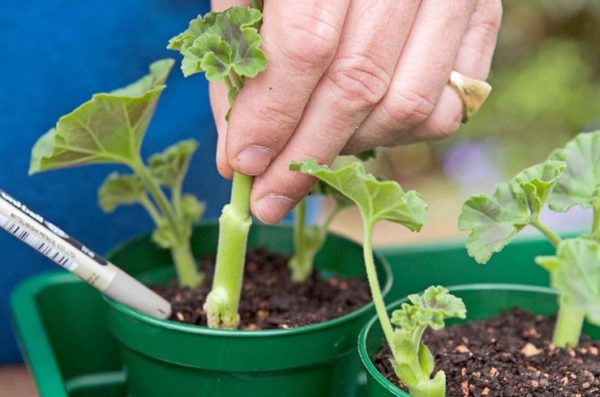 To grow a full-fledged plant from the cuttings is quite simple. For this, residues after autumn or spring pruning are used. It is better to choose cuttings with a lignified trunk. There are several popular rooting methods:
To grow a full-fledged plant from the cuttings is quite simple. For this, residues after autumn or spring pruning are used. It is better to choose cuttings with a lignified trunk. There are several popular rooting methods:
- Water. An activated carbon tablet is added to a small container with water and a stalk is placed in it. A glass is placed on a well-lit window sill and waiting for the roots. The process of their appearance in the spring takes about a week, and in the fall more than a month. The main risk when using this method is rot.
- Perlite or vermiculite. The stem is rooted in moistened perlite or vermiculite, placing the sprout at a slight angle - so a young plant will spend less effort on its own support. The plant is placed in a sanctified place or under a phytolamp.
- Peat. It is convenient to use a peat tablet. It must be soaked in water before use. After it is opened to the volume of the glass, a stalk is placed in the center with a slant obliquely. The advantage of this method is the ability to subsequently do transshipment instead of transplantation. This method has an advantage - peat in tablets is disinfected, therefore, the risk of death of the cuttings is minimal.
- Priming. In the soil, the plant takes root, as in a peat tablet, only the substrate needs to be prepared in advance. It is coughed in the oven or spilled with manganese for disinfection.
Cuttings are transplanted into a permanent pot after a noticeable growth and the formation of new leaves. It is better to wait for the moment when the roots will braid the entire existing earthen lump.
Landing
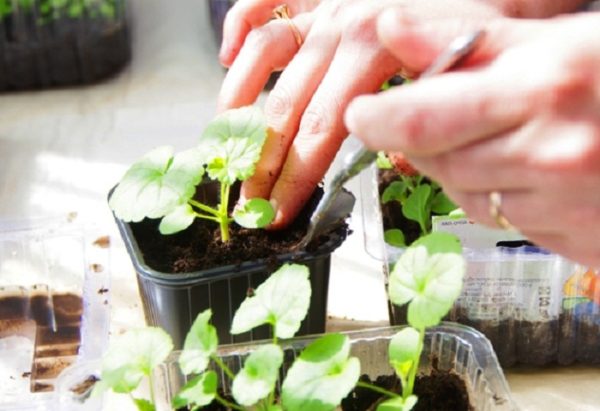 The plant should be transplanted carefully because its root system is tender. A new flowerpot should be two centimeters larger in diameter than the previous one. Use a large pot - not worth it, because the plant will not bloom. Geranium rooted from cuttings, or a bush after wintering, is recommended to be planted in April - during the period of growth and development.
The plant should be transplanted carefully because its root system is tender. A new flowerpot should be two centimeters larger in diameter than the previous one. Use a large pot - not worth it, because the plant will not bloom. Geranium rooted from cuttings, or a bush after wintering, is recommended to be planted in April - during the period of growth and development.
Transfer
Before replanting, the fist should be poured with water. So, it will be easier to remove the earthball from the flowerpot. The transplant is carried out in spring or autumn, after flowering. After transplanting into a new soil, the plant is not fed with fertilizers for 4 months. The substrate contains all the nutrients necessary for growth and development.
Possible problems
When growing geraniums at home, flower growers encounter such problems:
- leaves turn yellow;
- pests attack;
- leaves fall;
- the stem blackens or rots;
- spots appear on the leaves.
The appearance of these symptoms in any case indicates an attack by pests or improper care.
Why does indoor geranium die
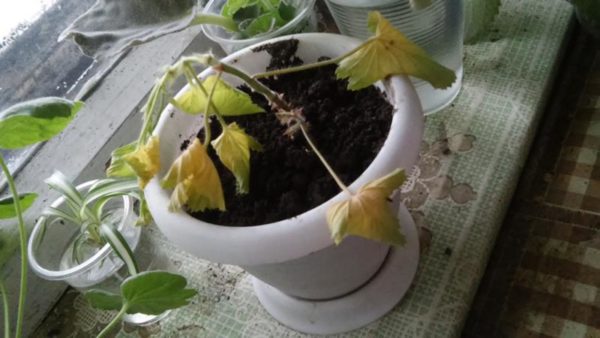 The main causes of indoor flower death:
The main causes of indoor flower death:
- unregulated watering;
- excessive air dryness;
- high temperature in the room;
- exposure to sunlight;
- damage to the root system during transplantation.
There are many reasons, in order to find out the true one, you need to carefully think about what changes the flower suffered. Often the problem is solved by changing the soil.
Diseases and pests: how to keep
Geranium is rarely affected by pests, because most often the plant dies when the owner does not comply with the basic rules. The death of old leaves located below the stem is a natural process. It is necessary to look for the cause if the young rudiments wither or fall, and rust forms on the reverse side.
- If the edges of the leaf turn yellow, you need to increase watering.
- Loss of turgor indicates an excess of moisture.
- Leaf fall is a lack of sunlight.
Medicinal properties and benefits of the flower
The leaves of zonal pelargonium release essential oils into the air and destroy viruses and bacteria in the room.The plant is recommended to be kept in a children's room, because it soothes and improves sleep. The leaves of the plant are used for otitis media, rhinitis and rheumatism. They make an infusion for the treatment of gum and throat diseases.
According to popular belief, the flowering of red geraniums in an apartment testifies to love and mutual understanding in the family. The plant normalizes the aura, makes the psycho-emotional environment more comfortable for life.
Conclusion
Pelargonium is a simple houseplant, the cultivation of which even a beginner grower will cope with. In summer, a flower can decorate a flowerbed or front garden - planting in open ground will do him good. You can get lush hats during the flowering period by providing a cool wintering and quality pruning in the fall. For compliance with these rules, geranium will be grateful.

 Geranium is not only a beautiful plant, but also a folk remedy for diseases
Geranium is not only a beautiful plant, but also a folk remedy for diseases